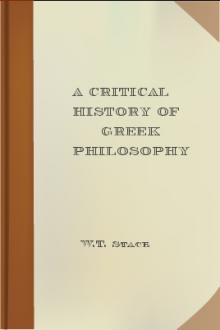A History of Indian Philosophy, Vol. 1 by Surendranath Dasgupta (desktop ebook reader txt) 📕

- Author: Surendranath Dasgupta
- Performer: -
Book online «A History of Indian Philosophy, Vol. 1 by Surendranath Dasgupta (desktop ebook reader txt) 📕». Author Surendranath Dasgupta
____________________________________________________________________
[Footnote 1: A.A. Macdonell's History of Sanskrit Literature, p. 31.]
[Footnote 2: Weber (Hist. Ind. Lit., p. 11, note) says that the word Brâhma@na signifies "that which relates to prayer brahman." Max Muller (S.B.E., I.p. lxvi) says that Brâhma@na meant "originally the sayings of Brahmans, whether in the general sense of priests, or in the more special sense of Brahman-priests." Eggeling (S.B.E. XII. Introd. p. xxii) says that the Brhâma@nas were so called "probably either because they were intended for the instruction and guidance of priests (brahman) generally; or because they were, for the most part, the authoritative utterances of such as were thoroughly versed in Vedic and sacrificial lore and competent to act as Brahmans or superintending priests." But in view of the fact that the Brâhma@nas were also supposed to be as much revealed as the Vedas, the present writer thinks that Weber's view is the correct one.]
14
system, unparalleled anywhere but among the Gnostics. It is now generally believed that the close of the Brâhma@na period was not later than 500 B.C.
The Âra@nyakas.
As a further development of the Brâhma@nas however we get the Âra@nyakas or forest treatises. These works were probably composed for old men who had retired into the forest and were thus unable to perform elaborate sacrifices requiring a multitude of accessories and articles which could not be procured in forests. In these, meditations on certain symbols were supposed to be of great merit, and they gradually began to supplant the sacrifices as being of a superior order. It is here that we find that amongst a certain section of intelligent people the ritualistic ideas began to give way, and philosophic speculations about the nature of truth became gradually substituted in their place. To take an illustration from the beginning of the B@rhadâra@nyaka we find that instead of the actual performance of the horse sacrifice (as'vamedha) there are directions for meditating upon the dawn (U@sas) as the head of the horse, the sun as the eye of the horse, the air as its life, and so on. This is indeed a distinct advancement of the claims of speculation or meditation over the actual performance of the complicated ceremonials of sacrifice. The growth of the subjective speculation, as being capable of bringing the highest good, gradually resulted in the supersession of Vedic ritualism and the establishment of the claims of philosophic meditation and self-knowledge as the highest goal of life. Thus we find that the Âra@nyaka age was a period during which free thinking tried gradually to shake off the shackles of ritualism which had fettered it for a long time. It was thus that the Âra@nyakas could pave the way for the Upani@sads, revive the germs of philosophic speculation in the Vedas, and develop them in a manner which made the Upani@sads the source of all philosophy that arose in the world of Hindu thought.
The @Rg-Veda, its civilization.
The hymns of the @Rg-Veda are neither the productions of a single hand nor do they probably belong to any single age. They were composed probably at different periods by different sages, and it is not improbable that some of them were composed
15
before the Aryan people entered the plains of India. They were handed down from mouth to mouth and gradually swelled through the new additions that were made by the poets of succeeding generations. It was when the collection had increased to a very considerable extent that it was probably arranged in the present form, or in some other previous forms to which the present arrangement owes its origin. They therefore reflect the civilization of the Aryan people at different periods of antiquity before and after they had come to India. This unique monument of a long vanished age is of great aesthetic value, and contains much that is genuine poetry. It enables us to get an estimate of the primitive society which produced it—the oldest book of the Aryan race. The principal means of sustenance were cattle-keeping and the cultivation of the soil with plough and harrow, mattock and hoe, and watering the ground when necessary with artificial canals. "The chief food consists," as Kaegi says, "together with bread, of various preparations of milk, cakes of flour and butter, many sorts of vegetables and fruits; meat cooked on the spits or in pots, is little used, and was probably eaten only at the great feasts and family gatherings. Drinking plays throughout a much more important part than eating [Footnote ref 1]." The wood-worker built war-chariots and wagons, as also more delicate carved works and artistic cups. Metal-workers, smiths and potters continued their trade. The women understood the plaiting of mats, weaving and sewing; they manufactured the wool of the sheep into clothing for men and covering for animals. The group of individuals forming a tribe was the highest political unit; each of the different families forming a tribe was under the sway of the father or the head of the family. Kingship was probably hereditary and in some cases electoral. Kingship was nowhere absolute, but limited by the will of the people. Most developed ideas of justice, right and law, were present in the country. Thus Kaegi says, "the hymns strongly prove how deeply the prominent minds in the people were persuaded that the eternal ordinances of the rulers of the world were as inviolable in mental and moral matters as in the realm of nature, and that every wrong act, even the unconscious, was punished and the sin expiated."[Footnote ref 2] Thus it is only right and proper to think that the Aryans had attained a pretty high degree
___________________________________________________________________
[Footnote 1: The Rigveda, by Kaegi, 1886 edition, p. 13.]
[Footnote 2: Ibid. p. 18.]
16
of civilization, but nowhere was the sincere spirit of the Aryans more manifested than in religion, which was the most essential and dominant feature of almost all the hymns, except a few secular ones. Thus Kaegi says, "The whole significance of the Rigveda in reference to the general history of religion, as has repeatedly been pointed out in modern times, rests upon this, that it presents to us the development of religious conceptions from the earliest beginnings to the deepest apprehension of the godhead and its relation to man [Footnote ref 1]."
The Vedic Gods.
The hymns of the @Rg-Veda were almost all composed in praise of the gods. The social and other materials are of secondary importance, as these references had only to be mentioned incidentally in giving vent to their feelings of devotion to the god. The gods here are however personalities presiding over the diverse powers of nature or forming their very essence. They have therefore no definite, systematic and separate characters like the Greek gods or the gods of the later Indian mythical works, the Purâ@nas. The powers of nature such as the storm, the rain, the thunder, are closely associated with one another, and the gods associated with them are also similar in character. The same epithets are attributed to different gods and it is only in a few specific qualities that they differ from one another. In the later mythological compositions of the Purâ@nas the gods lost their character as hypostatic powers of nature, and thus became actual personalities and characters having their tales of joy and sorrow like the mortal here below. The Vedic gods may be contrasted with them in this, that they are of an impersonal nature, as the characters they display are mostly but expressions of the powers of nature. To take an example, the fire or Agni is described, as Kaegi has it, as one that "lies concealed in the softer wood, as in a chamber, until, called forth by the rubbing in the early morning hour, he suddenly springs forth in gleaming brightness. The sacrificer takes and lays him on the wood. When the priests pour melted butter upon him, he leaps up crackling and neighing like a horse—he whom men love to see increasing like their own prosperity. They wonder at him, when, decking himself with
___________________________________________________________________
[Footnote 1: The Rigveda, by Kaegi, p. 26.]
17
changing colors like a suitor, equally beautiful on all sides, he presents to all sides his front.
"All-searching is his beam, the gleaming of his light,
His, the all-beautiful, of beauteous face and glance,
The changing shimmer like that floats upon the stream,
So Agni's rays gleam over bright and never cease."
[Footnote ref 1] R.V.I. 143. 3.
They would describe the wind (Vâta) and adore him and say
"In what place was he born, and from whence comes he?
The vital breath of gods, the world's great offspring,
The God where'er he will moves at his pleasure:
His rushing sound we hear—what his appearance, no one."
[Footnote ref 2] R.V.X. 168. 3, 4.
It was the forces of nature and her manifestations, on earth here, the atmosphere around and above us, or in the Heaven beyond the vault of the sky that excited the devotion and imagination of the Vedic poets. Thus with the exception of a few abstract gods of whom we shall presently speak and some dual divinities, the gods may be roughly classified as the terrestrial, atmospheric, and celestial.
Polytheism, Henotheism and Monotheism.
The plurality of the Vedic gods may lead a superficial enquirer to think the faith of the Vedic people polytheistic. But an intelligent reader will find here neither polytheism nor monotheism but a simple primitive stage of belief to which both of these may be said to owe their origin. The gods here do not preserve their proper places as in a polytheistic faith, but each one of them shrinks into insignificance or shines as supreme according as it is the object of adoration or not. The Vedic poets were the children of nature. Every natural phenomenon excited their wonder, admiration or veneration. The poet is struck with wonder that "the rough red cow gives soft white milk." The appearance or the setting of the sun sends a thrill into the minds of the Vedic sage and with wonder-gazing eyes he exclaims:
"Undropped beneath, not fastened firm, how comes it
That downward turned he falls not downward?
The guide of his ascending path,—who saw it?"
[Footnote Ref 1] R.V. IV. 13. 5.
The sages wonder how "the sparkling waters of all rivers flow into one ocean without ever filling it." The minds of the Vedic
____________________________________________________________________
[Footnote 1: The Rigveda, by Kaegi, p. 35.]
[Footnote 2: Ibid, p. 38.]
18
people as we find in the hymns were highly impressionable and fresh. At this stage the time was not ripe enough for them to accord a consistent and well-defined existence to the multitude of gods nor to universalize them in a monotheistic creed. They hypostatized unconsciously any force of nature that overawed them or filled them with gratefulness and joy by its beneficent or aesthetic character, and adored it. The deity which moved the devotion or admiration of their mind was the most supreme for the time. This peculiar trait of the Vedic hymns Max Muller has called Henotheism or Kathenotheism: "a belief in single gods, each in turn standing out as the highest. And since the gods are thought of as specially ruling in their own spheres, the singers, in their special concerns and desires, call most of all on that god to whom they ascribe the most power in the matter,—to whose department if I may say so, their wish belongs. This god alone is present to the mind of the suppliant; with him for the time being is associated everything that can be said of a divine being;—he is the highest, the only god, before whom all others disappear, there being in this, however, no offence or depreciation of any other god [Footnote ref 1]." "Against this theory it has been urged," as Macdonell rightly says in his Vedic Mythology [Footnote ref 2], "that Vedic deities are not represented as 'independent of all the rest,' since no religion brings its gods into more frequent and varied juxtaposition and combination, and that even the mightiest gods of the Veda are made dependent on others. Thus Varu@na and Sûrya are subordinate to Indra (I. 101), Varu@na and the As'vins submit to the power of Vi@s@nu (I. 156)….Even when a god is spoken of as unique or chief (eka), as is natural enough in laudations, such statements lose their temporarily monotheistic force, through the modifications or corrections supplied by the context or even by the same verse [Footnote Ref 3]. "Henotheism is therefore an appearance," says Macdonell, "rather than a reality, an appearance produced by the indefiniteness due to undeveloped anthropomorphism, by the lack of any Vedic





Comments (0)